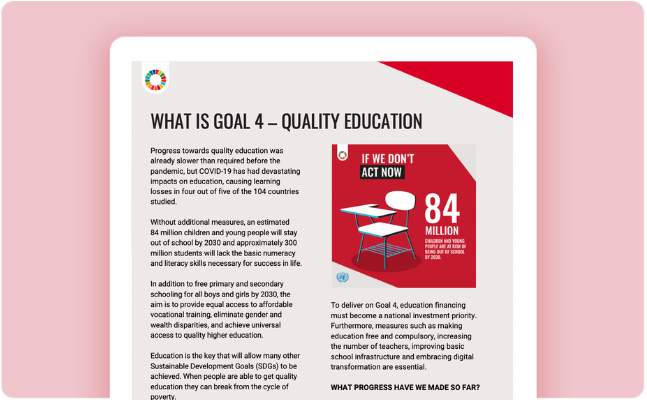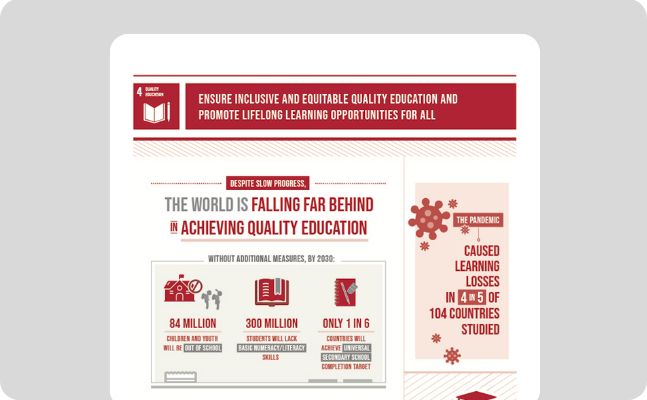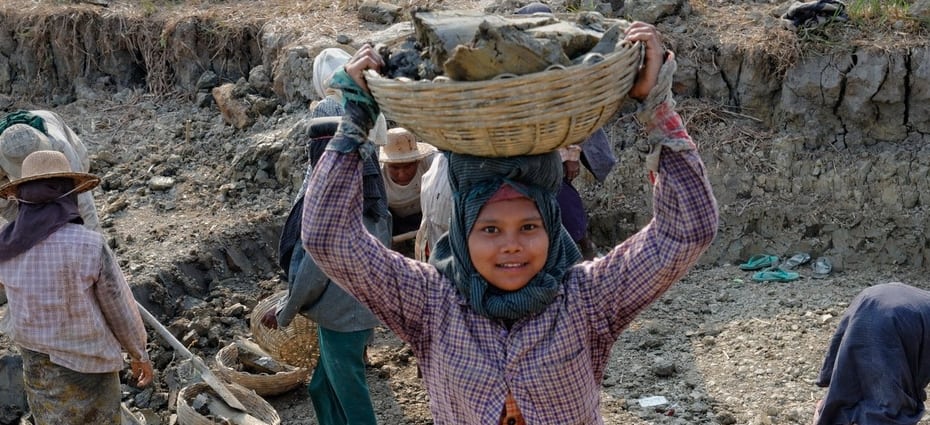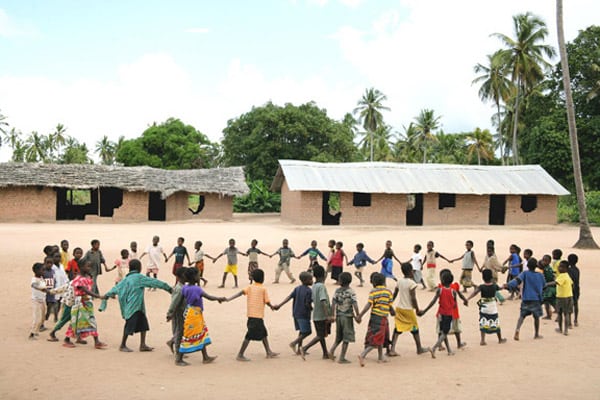Progress towards quality education was already slower than required before the COVID‑19 pandemic further slowed gains. Global completion rates have risen only modestly since 2015 and learning proficiency remains low.
As of 2023, 272 million children and youth were out of school, up 3 per cent since 2015 and disproportionately concentrated in low‑income countries.
In addition to free primary and secondary schooling for all boys and girls by 2030, the aim is to provide equal access to affordable vocational training, eliminate gender and wealth disparities, and achieve universal access to quality higher education.
Education is the key that will allow many other Sustainable Development Goals (SDGs) to be achieved. When people are able to get quality education they can break from the cycle of poverty.
Education helps to reduce inequalities and to reach gender equality. It also empowers people everywhere to live more healthy and sustainable lives. Education is also crucial to fostering tolerance between people and contributes to more peaceful societies.
To deliver on Goal 4, education financing must become a national investment priority. Furthermore, measures such as making education free and compulsory, increasing the number of teachers, improving basic school infrastructure and embracing digital transformation are essential.
What progress have we made so far?
While progress has been made towards the 2030 education targets set by the United Nations, continued efforts are required to address persistent challenges and ensure that quality education is accessible to all, leaving no one behind.
Between 2015 and 2024, the primary school completion rate increased from 85 to 88 per cent, the lower secondary completion rate from 74 to 78 per cent, and the upper secondary completion rate from 53 to 60 per cent. However, only two in three children in sub-Saharan Africa complete primary school on time.
What challenges remain?
In 2019, only 58% of children achieved minimum reading proficiency, and just 44% reached minimum mathematics proficiency by the end of primary school. Between 2018 and 2022, proficiency levels among lower-secondary students declined further—dropping by 15 points in mathematics and 10 points in reading.
Despite basic services in schools being essential for fair learning opportunities, progress has been slow, particularly affecting students with disabilities and girls. Globally, only half of primary schoolshave basic infrastructure for students with disabilities.
Economic constraints, coupled with issues of learning outcomes and dropout rates, persist in marginalized areas, underscoring the need for continued global commitment to ensuring inclusive and equitable education for all. Low levels of information and communications technology (ICT) skills are also a major barrier to achieving universal and meaningful connectivity.
Where are people struggling the most to have access to education?
Least developed countries faces the biggest challenges in providing schools with basic resources. The situation is extreme at the primary level, where over a third of schools lack basic sanitation, more than half lack electricity and over two thirds lack digital tools.
Inequalities will also worsen unless the digital divide – the gap between under-connected and highly digitalized countries – is not addressed.
Are there groups that have more difficult access to education?
Yes, women and girls are one of these groups. About 40 per cent of countries have not achieved gender parity in primary education. These disadvantages in education also translate into lack of access to skills and limited opportunities in the labour market for young women.
What can we do?
To deliver on Goal 4, education financing must become a national investment priority. Furthermore, measures such as making education free and compulsory, increasing the number of teachers, improving basic school infrastructure and embracing digital transformation are essential. We can aAsk our governments to place education as a priority in both policy and practice. Lobby our governments to make firm commitments to provide free primary school education to all, including vulnerable or marginalized groups.
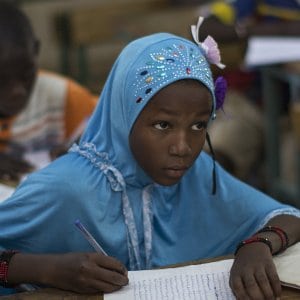
- 272 million children and youth were out of school in 2023.
- Between 2015 and 2024, the global primary completion rate rose to 88 per cent, lower secondary to 78 per cent, and upper secondary to 60 per cent, yet 754 million adults remained illiterate in 2024, with women accounting for 63 per cent of the total.
- Despite a high median rate for Internet usage (90 per cent), many lack essential skills, highlighting a significant gap between access and the ability to use the Internet effectively and safely.
4.1 By 2030, ensure that all girls and boys complete free, equitable and quality primary and secondary education leading to relevant and Goal-4 effective learning outcomes
4.2 By 2030, ensure that all girls and boys have access to quality early childhood development, care and preprimary education so that they are ready for primary education
4.3 By 2030, ensure equal access for all women and men to affordable and quality technical, vocational and tertiary education, including university
4.4 By 2030, substantially increase the number of youth and adults who have relevant skills, including technical and vocational skills, for employment, decent jobs and entrepreneurship
4.5 By 2030, eliminate gender disparities in education and ensure equal access to all levels of education and vocational training for the vulnerable, including persons with disabilities, indigenous peoples and children in vulnerable situations
4.6 By 2030, ensure that all youth and a substantial proportion of adults, both men and women, achieve literacy and numeracy
4.7 By 2030, ensure that all learners acquire the knowledge and skills needed to promote sustainable development, including, among others, through education for sustainable development and sustainable lifestyles, human rights, gender equality, promotion of a culture of peace and non-violence, global citizenship and appreciation of cultural diversity and of culture’s contribution to sustainable development
4.A Build and upgrade education facilities that are child, disability and gender sensitive and provide safe, nonviolent, inclusive and effective learning environments for all
4.B By 2020, substantially expand globally the number of scholarships available to developing countries, in particular least developed countries, small island developing States and African countries, for enrolment in higher education, including vocational training and information and communications technology, technical, engineering and scientific programmes, in developed countries and other developing countries
4.C By 2030, substantially increase the supply of qualified teachers, including through international cooperation for teacher training in developing countries, especially least developed countries and small island developing states
Related news
Coherent policy critical to tackling child labour, lack of decent jobs for youth – UN labour agency
Around 20 to 30 per cent of children in low income countries complete their schooling and enter the labour market by the age of 15, according to a new International Labour Organization (ILO) report prepared for World Day against Child Labour which is marked worldwide tomorrow.
Marking 10-year partnership, UNICEF and Gucci celebrate education successes across Africa and Asia
The United Nations Children’s Fund (UNICEF) is celebrating its longstanding partnership with luxury goods brand Gucci and marking a decade of successes in bringing access to quality education to more than seven million children across sub-Saharan Africa and Asia, the agency announced.
In Republic of Korea, UN’s Ban says education key for global peace and stability
Secretary-General Ban Ki-moon has returned to his native Republic of Korea (ROK) for the first time in two years in order to attend a series of international events, including a critical summit on education and development, the United Nations confirmed today.

